So El Poblado is too fancy for you. And Centro is a little too gritty. No worries. There’s a place in between, both location and character-wise.
That neighborhood is Belén. This working-class community just west of the Medellín River is one of the places I have lived in Medellín, and possibly my favorite. I once considered Poblado, but Belén is better.
I’ve met a lot of nice people, eaten at a lot of good restaurants, partied at a lot of good bars and clubs. There are good malls, great tiendas, and one of the city’s most popular tourist attractions and historic sites.
It’s close to almost everything. Public transportation is great. You can’t ask for anything else.
History of Belén
Belén is both a comuna (district) and a barrio (neighborhood).
The comuna is bordered by Calle 33 to the north, partly the Rio Medellín and mostly the domestic airport to the east, the mountains to the west, and Diagonal 75B to the south.
The neighborhood is at Calle 30 and Carrera 76, where you’ll find Parque Belén and the Belén stop on the Metro Plus, the city’s rapid transit bus system.
Belén is one of the city’s oldest communities. A map I saw in a Medellín history book shows the area now called Belén as a little spot in 1850, one of only a few — along with places now known as Centro and Poblado, among others — in what became Medellín.
From living there, I know the majority of the people are white or mestizo.
During the violent days everyone here wants to forget, Belén was quite dangerous, but not so much today, something you will read about later in this post.
One of the most famous people to come from the neighborhood is Francisco “Pacho” Maturana, the fútbol coach who led local professional team Atlético Nacional to the 1989 Copa Libertadores title. That made Nacional the best club team in South America that year.
Maturana later led Colombia to the Copa America title in 2001, the South American tournament among the continent’s national teams, which takes place every three or four years, depending on the World Cup, to avoid a conflict with the world’s biggest tourney.
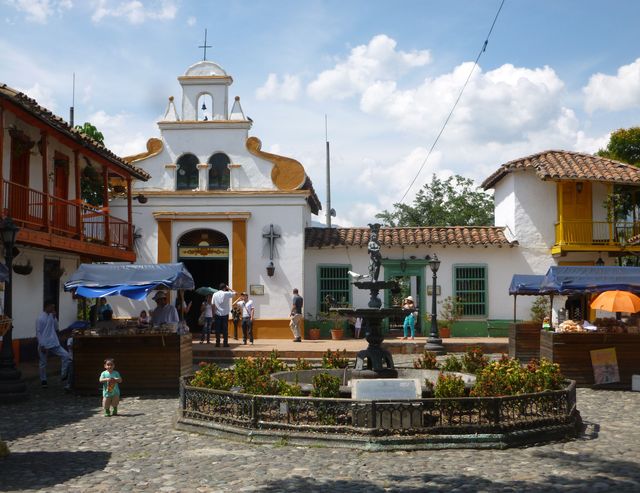
Points of Interest
One of the most popular places in Belén is Pueblito Paisa. Set atop a lush hill, the place has a church, a museum and small eateries, with the look and feel of an old Antioquian town.
Built in 1977, it’s a nice visit. I took my sister there when she came in December.
I read somewhere that if you decide to walk to the top, you should follow the road that circles the hill, instead of cutting up the stairs that go straight up, to avoid being robbed. I think that applies only at night.
Same applies to Parque Belén, and that of course depends on the hour. You should be fine until midnight.
There are a handful of little bars and tiendas near the park that can be fun. And during the day, there is almost always a group of older gentlemen playing dominos.
Food
After a walk up the Cerro Nutibara, you might be hungry, and if the small restaurants atop the hill don’t enthrall you, there are other options.
For comida tipica, try El Rancherito at Centro Comercial Los Molinos. It’s a little pricey for local food, but it’s good. I had the grilled pork.
For a light snack, just stop by any pastelleria. You can find pastries, and sometimes even better, pastries with meat, cheese and vegetables baked into them. My favorite is Panadería Legiseth on Calle 30, near Carrera 78.
If you feel guilty about what you’ve eaten, go to Unidad Deportiva de Belén, a huge sports complex along Carrera 65 at Calle 32B with soccer fields, basketball courts, a track, a pool, an archery range and outdoor gym. It’s one of the most impressive parks in the city.
City officials named it after Andres Escobar, the great soccer player who was killed shortly after scoring an own goal in a 1994 World Cup loss to the United States.
Nightlife
So you’ve seen a historic site, you’ve eaten, you’ve worked out. Now you’re ready for rumba, and Belén does not disappoint.
On Calle 33, from Carrera 80 to the bridge that goes over the Rio Medellín, there is a string of bars and clubs to entertain you. La Caverna de Baco has already made this blog for its friendly outdoor atmosphere, wild shots and paisa warmth.
A few doors down is King’s Town, a great place for reggae music.
At the other end of Calle 33, near Carrera 80, there’s Shots del Diablo, a place that fills with paisas looking for tragos (shots). These places are on the south side of 33.
If you cross the street, you’re in Laureles, where you have a lot of choices as well.
Shopping Malls
If you want a night without drinking, you can always go to the movies. You’ll find a theater at Los Molinos, one of the best malls in the city.
It’s got the upscale look of the posh places in El Poblado, shopping centers such as Sante Fe and Oviedo, but without the inflated prices.
There’s also a food court and other random eateries, along with an Exito grocery store and hundreds of shops in this centro commercial.
Another theater is in the Unicentro, the large shopping center on Carrera 65, north of Calle 33, which is technically Laureles but close enough to Belén to enjoy.
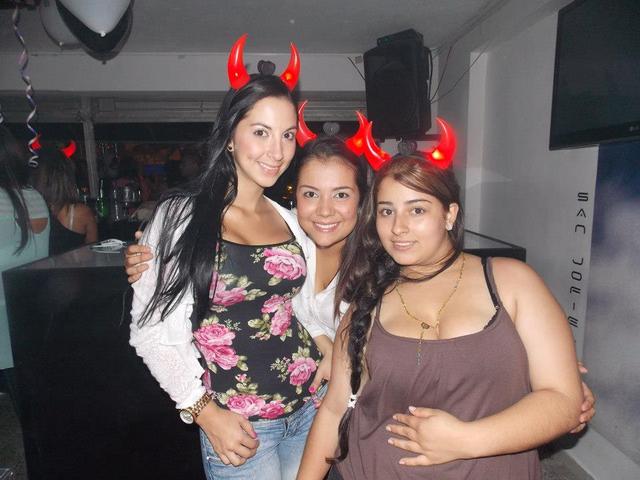
Safety in Belén
I have lost count how many times I have walked around in Belén at night by myself without any trouble, the same way I’ve lost count how many times random strangers have smiled, waved or greeted me as they passed. I always feel safe.
My first night out in the neighborhood, there was a dispute between two guys, almost a fight, and the police were there within minutes. One of them, the instigator, was taken away in a police van. To enhance safety, there are private security guards walking around in most places.
That said, you have to take the same precautions you should take anywhere in the city, especially if you look like a foreigner: don’t flash your money, don’t wear expensive jewelry and don’t pull out your iPhone or Blackberry.
And if you’re speaking English, don’t do it so loudly. You don’t want to announce that you’re a foreigner, and even if the people there can tell, being discreet is part of being humble and the paisas appreciate that.
That’s why I never speak English when a friend calls me while I’m on the bus or the metro. It’s always Spanish. When I couldn’t speak Spanish well enough to have a conversation, I spoke a little more quietly.
Anything can happen, of course. The Medellín metropolitan area is home to almost 4 million people. It would be ignorant to think there is no violent crime here. I’ve heard about people getting robbed.
Near my old place, I heard about someone getting stabbed in the chest. At the same time, it would be just as ignorant to think Belén is dangerous because it’s in a Colombian city.
Last I checked, New York, London and any other big city has crime, not just in its working-class neighborhoods but in all of them. Keep that mind.
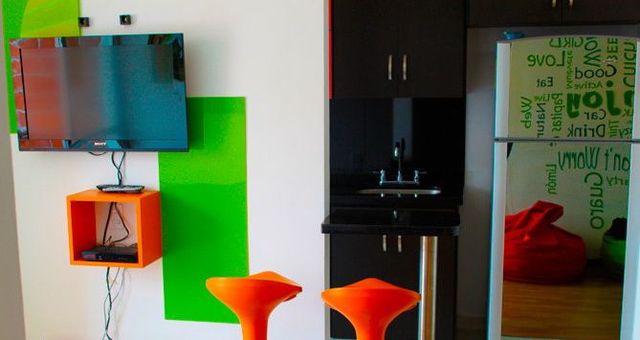
Cost of Living
It’s not as economical as Centro, but it’s a lot cheaper than El Poblado. Like I said before, it’s in between.
If you’re diligent, and you have the help of a paisa, you can find a nice one-bedroom apartment for 500,000 ($271) to $1.2 million pesos ($650) a month, the higher end units in neighborhoods such as Fátima and La Mota with furniture and utilities included.
But that’ll be your biggest expense. The nightlife costs half as much as El Poblado, on average 2,000 pesos for a beer instead of 5,000. And as long as you buy your groceries at the tiendas, you’ll save a lot. At these little stores, you’ll pay about a quarter the price you’d pay at Exito.
I’ve bought enough vegetables to feed four people for almost a week for only 6,000 pesos ($3). Only go to Exito if it’s the only place you can find something you want. I go there for my cereal, not much else.
Second Thoughts
In February, I wrote a post on the best neighborhoods in Medellín. Belén was ranked No. 2.
I was there recently, to meet a friend for lunch at La Colonia de Capurganá, a tiny seafood restaurant near Parque Belén that gives you a taste of the Caribbean Coast.
As I ate my delicious coconut-based soup and looked around, I realized how much I miss the area. It’s a real Medellín neighborhood, an area the working class calls home, the kind of demographic I was part of growing up in Hawaii.
My “best of” series will be a year old in August, when I write my 12th post. I plan to make it a revisions post, to use the feedback I get to perhaps modify the choices I’ve made.
Maybe Belén will jump Laureles and become No. 1.

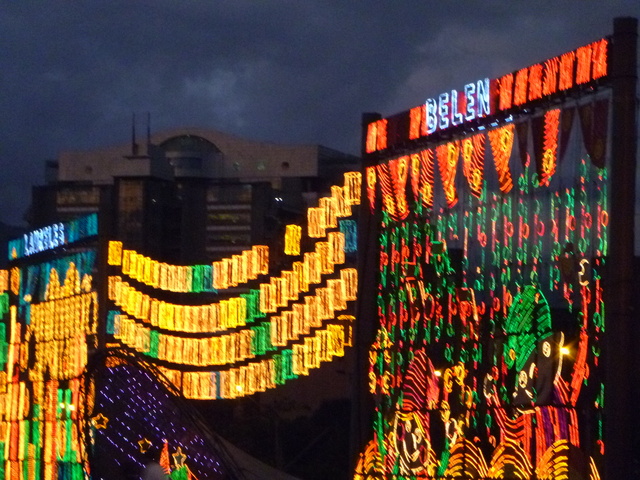

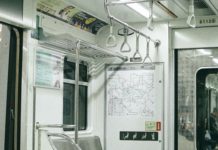


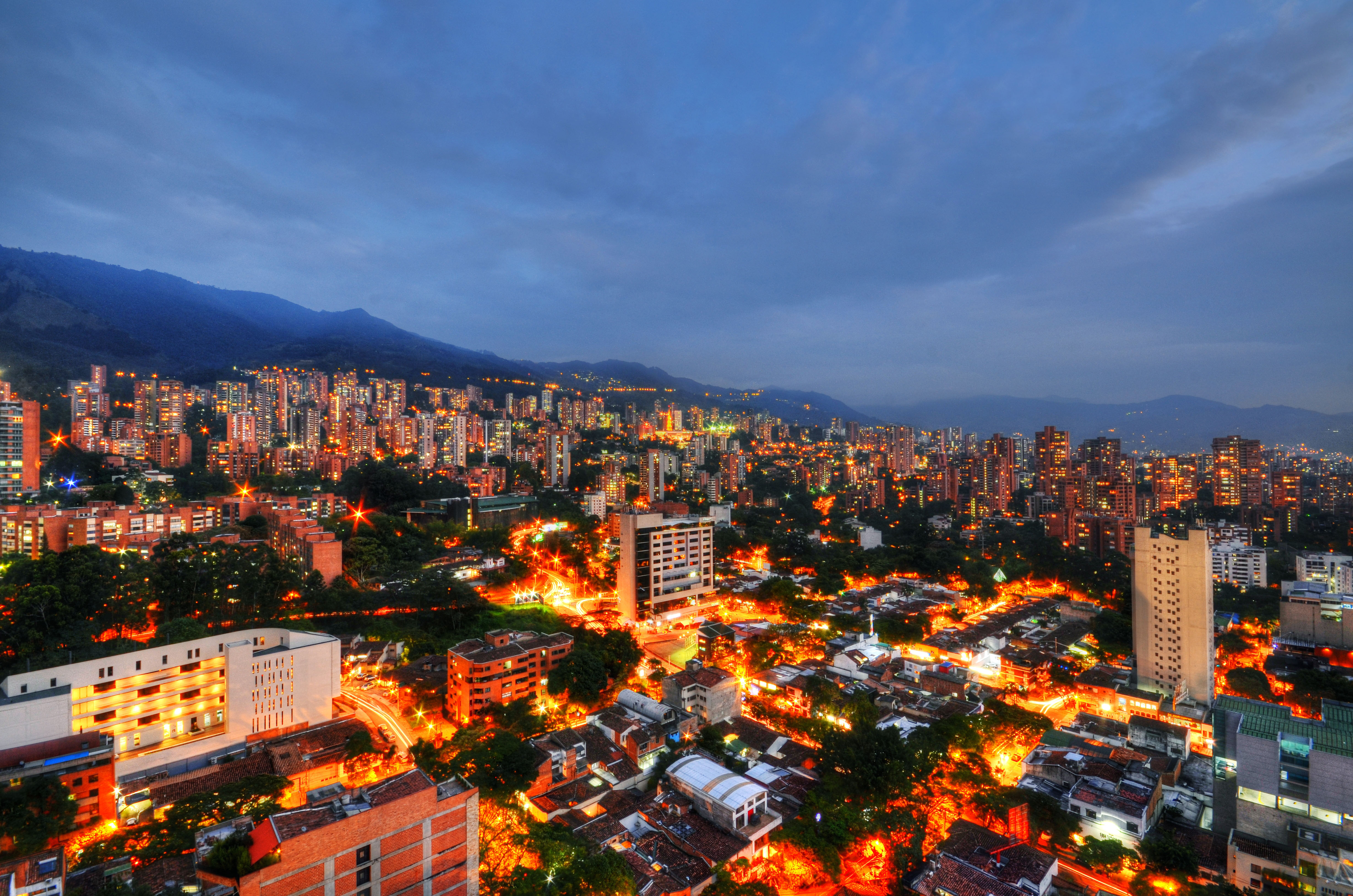






I’ve lived in Belen since I moved here and I love it. It has all the amenities you need, plenty of transport links and it has a nice, relaxed vibe to the place. You hit the nail on the head safety-wise Ryan, I think people drop their guard when they’re in “affluent” neighbourhoods. I feel very safe in Belen and the (very few) dodgy incidents have happened in El Poblado. You just have to take the usual precautions that you should be taking anyway. Anyway back to my original point, I would definitely recommend living in Belen!
Yes, the thieves know where the wealth is so they head for Poblado, but they can be equal opportunity. Unfortunately, I know people who’ve run into trouble in Belen too (myself included).
As an obvious foreigner (such as those of us with fair skin and blue eyes), it’s best to not let your guard down wherever you are in the city.
Thanks for reading, Naomi! I’m happy to hear you’re enjoying the neighborhood 🙂
I want to go and spend a few months there. sounds reasonable thanks for insights. but I just want to rent a room. is that possible. thanks in advance
Hey Jimmy,
Did you find any more information? I’m looking into moving in this area in 2017. I wanted to see how others were taking the steps. I.e. Who to contact for leases.
Hi Naomi,
I loved your comments but I am curious how things have changed in Belen over the last 5 or 6 years? Better? Worse? Love to hear more. My wife wants us to move to belen when I retire, which is pretty soon, so I’ve been reading a ton of stuff…but there’s only so much I can get without making a visit. Appreciate anything new you can tell me. Thanks again
Very nice article about Belen. Yes I liked it too..Just to add it can get a little noisy directly under the flight path from the local airport. By Unicentro there is a small salsa school more or less backing onto 33 I believe. For cyclists you have the cyloparque for a free 1.5 km circuit very popular early in the day and which is the other side of the airfield and there is a roller blade circuit and A BMX and stunt bike parque. Along 30 towards el parque de Belen there is a useful strip of shops specialising in furniture, tool, paint etc. I also liked watching the dominoes player en el parque. Hope this is helpful.
I experienced the airplane noise during my month living at the International House in Belen Malibu.
I don’t think Ryan mentioned it, but Belen is also a convenient place to live if you’re taking Spanish classes at UPB.
Oh, that’s right, Spanish classes. They’re available at Universidad de Medellín as well…
Good point about the airplane noise. I forgot about that. I get so accustomed to those kinds of things after a while.
Hey, is that bike park next to Unidad Deportiva de Belén? I’ve seen it. Thanks for pointing that out. I forgot to include it and it looks like a great place for kids to have fun.
As for the salsa school, I thought it was tango? But I should have mentioned it nonetheless. Same with the furniture places along 30.
You know Belén well! Cheers!
Before you recommend a comuna like Belén to your readers and with security being a big concern in Medellín you should also should let them know the facts. I have lived in two different barrios in Belén and I like it but I would not recommend many areas of Belén for a foreigner new to Medellín. I lived in Fatima for three months where I rented a furnished apartment near the Unicentro mall that was a nice neighborhood and I now have lived for over a year in a newer high rise apartment in Loma de los Bernal that I furnished (near La Mota) that I like even more. Both places I have lived in Belén are in estrato 5 areas but that is actually pretty uncommon in Belén. According to government statistics for 2011 (I haven’t seen 2012 numbers yet), 58.7% of the population of Belén lives in lower Estrato 1-3 areas. Only 18.9% of the population of Belén lives in estrato 5 areas and there are no estrato 6 areas in Belén.
This compares to a comuna like Laureles/Estadio where 62.5% of the population lives in estrato 5 areas and almost all the rest are in estrato 4. And in El Poblado, 75.5% of the population lives in estrato 6 areas with another 16.7% living in estrato 5 – that’s why it’s the most expensive area.
The bottom line is that Belén is large with some areas that I think would be fine for a foreigner to live. But there is also many areas in Belén that I feel are more dangerous (especially after dark) that I would not recommend for foreigners. I know several who have run into security/safety problems in Belén. I also lived for nearly a year in Estadio and think that pretty much all of Laureles/Estadio I would recommend for a foreigner to live looking to avoid the high costs in El Poblado (where I also lived for three months and disliked).
There is some correlation to lower estrato areas having higher crime and murder rates. To each his own and I know some foreigners living in estrato 2 and 3 areas but I personally would not consider living in an area lower than estrato 4 in Medellín. Here’s some facts to back that up.
Comuna / 2011 Population / Murders in 2010 / Murders in 2011
El Poblado / 122,469 / 20 / 19
Laureles/Estadio/ 120,996 / 46 / 40
Belén / 194,174 / 91 / 116
And there is also a correlation between the price you pay for rent to what estrato. You can pay much less for rent in lower estrato neighborhoods in Medellín but you are also likely taking some more risk.
Also Belén is large and not everywhere do you hear the planes from the airport. I didn’t hear them in Fatima and also don’t hear them in Loma de los Bernal. Another drawback you didn’t mention about Belén is not having good access to the metro, needing to use buses or taxis instead.
I agree that it’s important for readers to know not all barrios (neighborhoods) within a comuna (district) are created equal.
Our goal with these neighborhood reports is to paint with broad strokes, in order to introduce foreigners to the various comunas and barrios. It’s still up to the individuals to do their research, as we all have different budgets, and priorities in choosing a place to stay or live.
Thanks for sharing such detailed advice. I’m familiar with the homicide rates in different parts of the city as well (ColombiaReports.com does a good job of sharing that info for the major cities in Colombia, including Medellin, on an annual basis).
those are all great points, jeff, and thanks for the stats. you’re right…for some new foreigners, belén might not be the best place. but it might be best for their budget, which is why i pointed out in the story that violent crime does happen there. i just wouldn’t say it’s as bad as some people think or as bad as it used to be. you just have to exercise caution, like in any big city. happy to hear you like your place in la mota. that’s a great neighborhood 🙂
Hey Ryan,
Great article, buddy. My old apartment at the small park, C33 @ K80 was the best place Ive had so far. Right between Belen and Laureles, it was perfect. Close to Los Molinos mall, Estadio, bars, clubs, everything. I agree with you, Belen and Laureles and nearby areas are best Ive seen in Medellin. Reasonably cheap and a very local feel that I havnt seen in Poblado, Centro or Envigado. Cant wait to get back, but unfortunately I have to wait until end of this year.
BTW, I’m no Spanish expert and I look very Scandinavian so I obviously stand out, but I’ve never felt intimidated or scared in Belen or Laureles. I think it has more to do with your attitude than anything else.
great points my friend! can’t wait until you get back. i’ll show you my new neighborhood. it definitely has a local feel. you’ll turn a lot of heads while you’re there. i don’t think someone of your background has ever stepped foot in my neighborhood. but everyone here is very nice and it’s so mellow. cheers!
Hey, great post! I’m looking to spend some time in Medellin next year and hearing more detailed information about which barrio to live in is always useful. I might try to brush up on my espanol before I arrive though.
We’ll be doing more of these Erin, so stay tuned (or check back monthly for new ones)!
“From living there, I know the majority of the people are white or mestizo.”
Wow, just wow.
Maybe its my Americanization but reading that sentence is just mind blowing. I dont know of any educated writer that would make such a statement. What purpose it serve other then to imply that the author is scared of non-white/mestizos?
I was born in Medellin and will be returning in August of 2013 after 34 years. I really hope I dont have to deal with people like Ryan when I visit.
There is nothing racist in Ryan’s text. In that paragraph he is merely stating a fact. Most people don’t care about color, but would still find it interesting to know what kind of people they will see on their trip, the same way climate is a factor of interest.
You should stay in the US where it seems OK to be overly sensitive, and where people like you can get away with being offended by every small thing that is not politically correct. Yes, you are Americanized.
Hi Trey,
Yes, speaking as an American, it’s your Americanization. Colombians, like South Africans, are much more blunt when speaking about different races.
I still shudder when I hear a Colombian refer to a black friend as “negrito” or “negrita” but it’s a term of endearment there. I’d never call a friend “mi negrito” but that’s because I was raised in the ultra-politically correct United States.
In many countries, people are referred to by the color of their skin. Not in a derogatory manner, but simply because they have white, black, or brown skin.
When you spend time in these countries, you slowly begin to realize it’s not that big a deal, but having lived most of my life in the US, I still perk up and make a mental note of what someone just said because it’s so uncommon in the US.
In Thailand falang or farang is the same as gringo. I have heard it spoken often and know there is no offense meant. It means I am not Thai. No big deal. Coming from America I understand how overly sensitive people in that country have become. My advice is, if you are moving abroad, leave America behind and embrace the freedom found in the rest of the world.
This article is more of your good work. I have enjoyed your site a great deal. I am currently back in the US but hoping to head south to Colombia and Ecuador for a scouting trip soon.
Chao
Just a comment on the term Gringo and how it is used in Latin America.
In my experience, in Mexico and Central America it is more often used as a derogatory label but in Ecuador, where I lived for 13 years it simply meant a North American/American. Chile seemed to be the same and throughout South America it seems to be more of a label of where you are from vs demonizing you.
trey, i understand your discomfort but let me explain a couple of things…
1. as dave and bjorn both wrote, there was nothing malicious about what i wrote. i simply reflected the way things are here. and if you look at a u.s. census sometime, they use the word black to describe one of the races.
2. it humored me that you would suggest i am uneducated. i have a master’s degree from george washington university. maybe you’ve achieved more academically but i’m proud of what i’ve accomplished.
3. if you don’t want to run into people like me when you come here, i would advise you to: a. not come; b. don’t interact with anyone; or c. learn to relax a little and focus on the positives about this place, of which there are many.
this blog is intended to help people assimilate to the way of life here. considering i am of mixed ethnicity, i would never do or say something to intentionally offend someone along racial lines. i simply said things the way friends here have referred to themselves.
I lived in Ecuador 13 years and it was very common to refer to any black person as “Negro” . IN fact it was THE WAY, no malice was meant and I’ve seen many times a black person come up and the group of people would say “Hola Negro, como estas” then give them a big loving hug.
First off, great article. I’m from Los Angeles, CA and lived 3 years in la costa (Santa Marta). Like Ryan mentioned, and others as well, you take the same precautions you would traveling abroad. I’m in middle of getting a job teaching in Medellin and do not want to live in Poblado. Yes, its very nice, but like someone said, its a ladrone main target. I have a friend who lives in Belen, paisa, and she loves it. I had ONE incident in 3 years in Santa Marta. My first week in Colombia. I didn’t know much. I was walking with my “nice clothes” iPhone in hand, and in a secluded area. dando papaya as they say jajaja. After awhile you just learn from locals and other foreigners living there. There are do’s and dont’s. I visited Medellin 3 times while living in Colombia, and its a place I want to live in. This article might have sold me on Belen even more. Thanks!
David, I subscribed to your newsletter about a year ago in my search for more information about Colombia. I visited Cartagena in January, 2011 and fell in love. I must say to Ryan, this is the most informative yet; but to Trey’s point, You are not targeting the locals, you are targeting Americans (most likely) considering relocation to Colombia. So, our Americanization should be taken into consideration. You have a Master’s Degree, good so you should be able to understand what I am saying. I don’t care how much schooling you have, Education is how you use your schooling. And David Lee, the reason I stopped looking to your news letter is that I realized that you were not trying to communicate with me (a Black American). Your comment about the blue eyes and fair? skin only confirms it. You would do a greater service if de-racialize your tone and be more culturalized. Focus of things that anyone of any ethnicity could enjoy about the place. Unless, as you have stated you think Blacks would be better not to come because of people like you (a very uneducated statement for a person with a Master’s degree. I am a baby boomer and fully capable of expatriation. I hope my biggest problem don’t end up being White Americans taking their brand of Racism to South America.
Hi Willie,
Thank you for continuing to read Medellin Living. I appreciate your perspective and feedback on what I (and many) will agree is a difficult topic.
“You are not targeting the locals, you are targeting Americans (most likely) considering relocation to Colombia. So, our Americanization should be taken into consideration.”
Exactly. This is why we feel it’s important to address the fact that some Colombians are much more blunt about how they refer to people of different races. This will come as a culture shock to those of us who grew up in the U.S. To Colombians, it’s normal.
“And David Lee, the reason I stopped looking to your news letter is that I realized that you were not trying to communicate with me (a Black American). Your comment about the blue eyes and fair? skin only confirms it.”
Our goal is to be inclusive, however, you make a valid point bringing this to my attention. I’m a single, white, straight male so in writing about my experiences in Colombia that’s reflected.
However, I recognize this blog has become a de facto resource for information on Medellín and I need to be more conscious of the broad demographic of our readers. We’re making an effort to provide information for the LGBT travelers and address the question of how African American travelers will be treated in Medellín. We will continue to do our best to make Medellín Living as inclusive as possible going forward.
To that end, if at any point you are interested in writing a guest post based on your perspective and experience in Colombia, I would be happy to consider it.
“Focus of things that anyone of any ethnicity could enjoy about the place.”
99 percent of our stories and words fall under this category. You happened to find one of a handful of discussions about race and are extrapolating that to suggest it’s pervasive in our editorial policy and commentary, which I don’t feel is the case.
“Unless, as you have stated you think Blacks would be better not to come because of people like you (a very uneducated statement for a person with a Master’s degree.”
This was an insensitive statement, and I’d like to personally apologize for it. I suspect this was an attempt by Ryan to inject some humor into the discussion, and it fell short. I don’t believe there was any malice behind it.
Thanks for sharing
I am looking for information about belen…
being myself from medellin but not knowing my city pretty well ….i assumed it was near by belencito……
i am pleased to find you article and gain some local point of view
My girlfriend office its to be moved there and i am very hungry to get some peace of mind
I have been out of medellin for 12 years and just cant tell whats what any longer
You can tell a lot from pictures about medellin
Glad i find this …thanks
Hello Ryan and thanks for all your valuable research you helped me make up my mind as to where I would like to stay it is Belen, i’m coming to Medellin in October for several months at a time hopefully for good.Thanks.
Why is it important to know that there are mostly white and mestizo people there? Hum…, I have an idea…